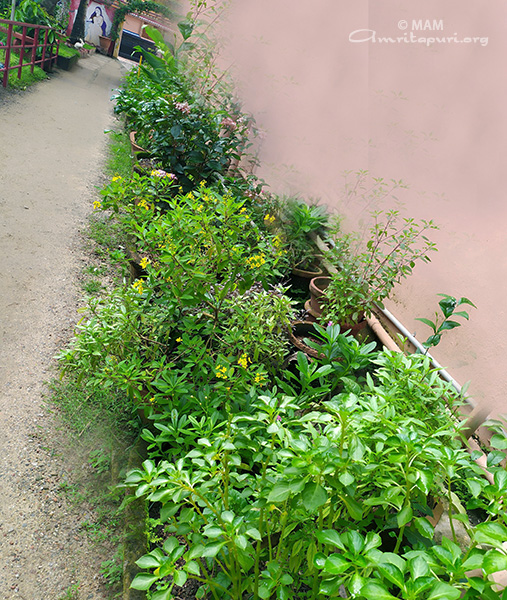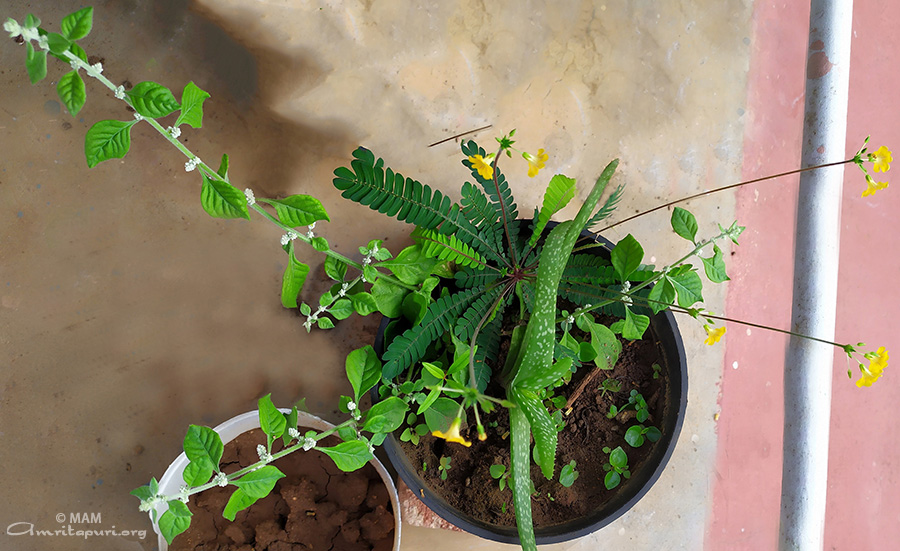Amritapuri – A Bouquet of Flowers VI
Dasapushpa: A New Concept in Gardening
Forest is what is given to us; garden is what we have to make out of it…not desert. Left to itself the earth brings forth rich flora and fauna. Soil has all the seeds in it. Think of it: first the planet was there, and then we were introduced. So Earth has been providing for us. “Earth is the Mother of mothers,” Amma said recently.
Bhumi is described as Navanavonmeshashalini prithavi, meaning Earth is able to rejuvenate Herself, which She does from time to time. During these lock-down days, just like wild animals have found their freedom of movement, plants and trees and shrubs and bushes are all enjoying their right to existence.

Herbs among plants
Ten Flowers for Ramayana Masa
The Kerala month of Karkeedagam – mid-July to mid-August – is better known as Ramayana Month. People take to reading of the Ramayana. After dinner, members gather around a lamp and idol or picture of Sri Ramachandra, and, as one reads aloud the others listen. Keralites read Sage Veda Vyasa’s Adhyatma Ramayana, recreated in Malayalam in Kilipattu style by Sri Tunjattu Ramanujan Ezhutacchan. The poet narrates the moving story of Sri Rama and Sita Devi, expounding its spiritual message.
During this month, the following ten specific flowers assume importance: Karuga, Vishnukranti, Puvamkurutan, Muyilceviyan, (the latter two are lookalike tiny purple flowers…difference is in bunch and in leaf shape; one has leaves the shape of peacock feather, and ‘he is Muyilcheviyan’- meaning – fellow with -leaves like- peacock -ears; they say this endearingly. To note: the plant is personified; also our ancients had birds and other beings in their consciousness.) Mukkutti, Kayyonni, Cheroola, Uzhinnya, Tirutaali and Nilappana. These tiny, otherwise insignificant flowers used to grow naturally in anybody’s back and front yards here till a few decades ago, till chemicals entered waters and soil.

Muyilcheviyan and Cheroola 
Mukutti 
Cheroola 
Mukutti and Cheroola
Songs of the season make references to adhidevata of each flower who grants specific blessing on the worshipper. The common grass called Karuga has Lord Sun as its presiding deity; he grants the devotee the boon of well-being. The Vishnukranti, humble yet colorful, now grown in gardens also, has blue hued Krishna as its deity who grants the devotee, nearness to Lord Vishnu’s Holy Feet. Parvati Devi is pleased by the offering of Mukkutti, a very pretty tiny plant with dramatic features and yellow flowers, and she grants the gift of devotion.
It is believed that Sita Devi, who spent her post-Ayodhya days in North Kerala’s Pulpally, used to wear in her hair ten specific greens. Sita Devi is the daughter of Mother Earth; she returns to her mother in this very place according to local belief. Those ten are revered as Dasapushpam and are celebrated during Kerala’s Ramayana Masa. All these used to be worn in the hair every day for ten days by womenfolk during this month. The medicinal qualities in them gave them greatest blessings, I am sure.

Puvamkurutan 
Vishnukranti 
Puvamkurutan 
Vishnukranti
Amma says there is not a single thing in God’s creation that is useless. Amma tells the story of Ayurveda students who search for a plant- without-use; their Guru has asked for such an herb as Guru dakshina. On searching far and long the disciples realize that there is no such plant, not even grass that has no utility. What is picked as weed, the farmer uses as cattle fodder, or manure. Ayurvedic pundits pick herbs from among bushes of natural growth. The dawning of this understanding in his disciples, the Guru says, is the true gift he received from them, since Gurus are best pleased when their disciples attain knowledge. This story helps us to understand Advaita, the ultimate spiritual precept, where everything is perceived as God Consciousness only, and nothing as devoid of Divinity.
As one goes looking for tiny purples of puvamkurul or muyilcheviyan, one notices n number of other small growths in the bushes. Each one, seniors will tell untiringly, is medicinal, used in home medicine. Also these tiny growths are ever eager to assert their lives in humble manner, willing to grow anywhere. Ancient wisdom made best use of available natural vegetable resources and hence flourishes Ayurveda, and hence rural Indians -thanks to their nature friendly life style- score better where health and herd immunity is concerned.
Dasapushpam concept makes a strong case in favor of natural vegetation. Amritapuri Ashram retains much of its soil from going chemical through its nature-friendly waste management. In spite of its nearness to the sea, a number of herbs and so called weeds grow on either side of our walkways whose utility you and I may not know. A new concept of garden that finds a midpoint between a jungle and a park, seems to be emerging. Making things too tidy means making plants dependent only on what is fed. The Flower in the classical Woeful Song of a Flower, Pushpavilapm, wails: (we flowers after our prime time fall to the feet of our Mother, the plant, hoping to merge with her. But you humans… sweep us with a broom harsh and throw our carcass out in the dreary dust.)

Kaiyonni 
Karuga Grass 

Kuzhittura garden and Saraswati garden at either ends of Ashram have given nature almost a free hand; in the area where we 3000+ live, we have trees and plants intentionally grown, but in a nature friendly manner, under Amma’s direction. Among them when a modest mukkutti comes up or a purple puvamkurutan twinkles, we see Mother Earth’s blessings on this God’s own island.
Om

